
Those two facts really have nothing to do with each other, or at least they shouldn’t have anything to do with each other. But on the other hand, acknowledging those two facts is important to understanding public attitudes about the legalization of cannabis.
For the most part the public has either figured out, or is starting to figure out, that cannabis use does not cause crime.
One big reason for this is that more and more people are realizing that they know people who use cannabis. It doesn’t hurt the education process that crime has been falling for the last two decades. The changes in public opinion about the legalization of cannabis is a very interesting and important topic, but it’s actually not the topic of this column.
Instead, consider how the drop in crime affects how law enforcement views cannabis law reform.
There is a growing movement among law enforcement professionals in support of drug policy reform and the legalization of cannabis, with tremendous leadership by Law Enforcement Against Prohibition (LEAP).
On the other hand, in many areas, law enforcement officers are steadfast in their opposition to cannabis legalization.
For example, in 2010 the International Association of Chiefs of Police and the National Sheriff’s Association issued a joint statement opposing Proposition 19 to legalize cannabis in California, in which they explained that “the simple truth is that legalizing narcotics will not make life better for our citizens, ease the level of crime and violence in our communities nor reduce the threat faced by law enforcement officers. To suggest otherwise ignores reality.”
The National Sheriff’s Association also passed a resolution in 2015 opposing both legal and medical marijuana, in part because “the threat to public safety [of illegal drugs, including marijuana] . . . in terms of highway safety, criminal activity, and domestic violence, are well-documented” and that “the legalization of marijuana will do little to weaken the black market as many drug cartels are unwilling to work within a regulatory system for fear of revealing the extent of their other illegal activities.”
The assertions of these law enforcement representatives are. . . how should one put it . . . highly suspect and vulnerable to critical review. But that’s both self-evident and a matter for another discussion.
The point here is that law enforcement opposes the legalization of cannabis.
So let’s recap. Cannabis use is up, crime is down, and law enforcement opposes the legalization of cannabis.
Crime in the United States is an annual report produced by the Uniform Crime Reporting Program (UCR) of the FBI. It provides two types of data, (1) offenses known and reported to police and (2) arrests. The arrest data is the source for reports on trends in marijuana arrests and racial disparities in marijuana possession arrests.
The offense data, though, is what informs national discussion of crime trends.
Offense data indicates the number of crimes reported to police, and it tracks eight specific types of crime. Violent crime monitors reported crimes involving murder, aggravated assault, rape and robbery. Property crime monitors burglary, larceny (theft), motor vehicle theft and arson.
The last two decades have been good for public safety.
It’s best to look at this data in terms of rates, the number of offenses per 100,000 population. The violent crime rate has dropped steadily from 684.5 per 100,000 in 1995 to 365.5 in 2014. The property crime rate has dropped from 4,590.5 in 1995 to 2,596.1 in 2014.
In other words, over the last 20 years the violent crime rate has dropped 47 percent and the property crime rate has dropped 43 percent.
There is another term for these types of crime. They are called street crime, and they result in an annual economic loss of less than $20 billion. On the other hand, white-collar crime (a variety of offenses including securities and other types of fraud, identity theft, embezzlement, unsafe products and hazardous working conditions) results in an annual economic loss of about $300 billion annually.
In fact, the public’s priorities, when it comes to crime, are undergoing change.
The investigation and prosecution of white-collar crime is becoming more and more important to the public. Another emerging priority is the investigation and prosecution of sexual exploitation of children. One manifestation of both concerns is the proliferation of computer crime. These crimes are not prevented or addressed by routine police patrols by rank and file officers.
The traditional work for cops on patrol has been to protect and serve the public, and this has been traditionally directed at preventing and responding to street crime.
But these days, public concerns about crime are shifting to other types of crime, crime that requires different responses from law enforcement and law enforcement professionals with more education and more training.
There remains a need for police patrols and community policing, but the growth areas in law enforcement are elsewhere.
Might this be causing some police officers some anxiety about their long-term job security? It shouldn’t.
But crime is down, marijuana use is up, support for legalization is growing and stopping police from arresting people for marijuana use results in even less work for the cop on the beat. Crime in the United States is changing, and to serve the public, law enforcement must adapt.
In this context, understanding these facts, it’s hard to look at the reasons law enforcement opposes the legalization of cannabis without wondering if their real concern is simply job security.

No comments:
Post a Comment